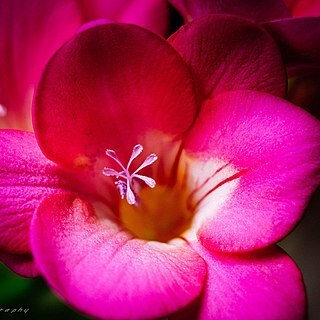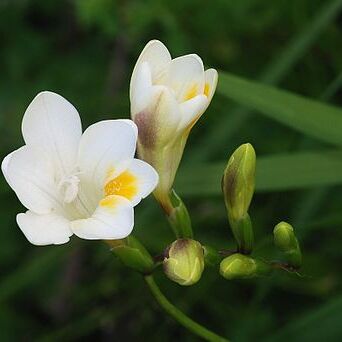Perennials with corms with fibrous tunics. Leaves several, the lower 1-2 entirely sheathing (cataphylls); foliage leaves plane, firm or soft-textured. Inflorescence a spike, usually flexed at the base; bracts herbaceous to coriaceous, the inner shorter than the outer, often brown at apex. Flowers zygomorphic, shades of pink to red, or whitish usually with contrasting darker markings on the lower 3 tepals; perianth-tube well developed, either slender and cylindric throughout or narrowly campanulate; tepals subequal or the upper larger and erect and the 3 lower inclined to horizontal. Stamens unilateral and arcuate, filaments usually mostly included; anthers parallel and contiguous. Ovary globose-oblong; style exserted, the branches filiform, each deeply divided and recurved. Capsules globose, coriaceous, usually papillate to rugose. Seeds few-many per locule, oblong to globose, glossy, smooth or ruminate.
Small perennial herbs with annual leaves and flowers. Corm ovoid; tunic of netted fibres. Leaves mostly basal, lanceolate to ensiform, flat, soft-textured, with prominent midveins. Stem usually erect, flexed horizontally below spike. Spike secund, usually dense. Bracts herbaceous or membranous, the outer entire, inner bifid. Flowers erect, zygomorphic. Perianth tube curved, narrowly cylindrical below, widened abruptly into cylindrical upper portion; lobes sub-equal to unequal, shorter than tube. Stamens unilateral; anthers oblong, basifixed. Style arched behind stamens, trifid near apex, the branches linear, bifid, recurved; stigmas 6. Capsules obloid, papillose. Seeds globose, smooth. [The Flora of Australia Volume 46 (Cooke 1986) treated Anomatheca and (above description of) Moraea as separate species; the description here requires revision to include Anomatheca -Editor, 22 October 2020.]
Perennial herbs with annual leaves and flowers. Corm rounded; tunic of netted fibres. Basal leaves 2 to several, ±ensiform, soft-textured. Scape erect, terete or winged, often branched. Cauline leaves few, lanceolate. Spike secund, lax, flexuose. Bracts herbaceous. Flowers erect, zygomorphic, sometimes bilabiate. Perianth tube straight, narrow at base, widened towards apex or ±cylindrical, usually longer than lobes. Stamens unilateral, arched. Style erect, filiform, trifid near apex; branches bifid, recurved; stigmas 6. Capsule obloid, papillose. Seeds few, globose, smooth.
Summer-green perennial, cormous with fibrous tunic. Leaves distichous, flattened. Spike secund, axis usually bent at abrupt angle from stem. Flowers several, often sweet-scented, alternate on axis, all curved toward upper side, each within 2 small green membranous spathe-valves; tube distinct, usually curved, lower portion slender, funnel-shaped above; lobes all similar, or 3 inner dissimilar. Stamens asymmetric. Style filiform; style-branches 3, each deeply bifid. Capsule subglobose. Seeds many. Spp. c. 20, all of S. Africa. Adventive sp. 1.


